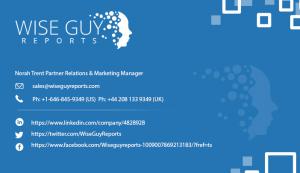Hemophilia A, B Pharmaceutical and Healthcare Pipeline Review H2
Hemophilia A, B Treatment Pipeline Review H2 2016
PUNE, INDIA, January 6, 2017 /EINPresswire.com/ -- Get Sample Report @ https://www.wiseguyreports.com/sample-request/782017-hemophilia-a-and-b-non-factor-therapySummary
Hemophilia is a rare disease affecting more than 400,000 people worldwide. Hemophilia A is four times as common as hemophilia B, and more than half of patients with hemophilia A have a severe form of hemophilia. Males have a much higher chance of developing hemophilia because they only receive one copy of the X chromosome from their mother.
The mainstay of treatment for hemophilia is to replace the missing factor VIII or factor IX, produced using plasma-derived or recombinant methods. Some patients develop inhibitors to factor VIII or factor IX treatment and need a bypassing agent, such as factor VIIa, to resolve bleeds. Patients of hemophilia A or B often require lifelong treatment to prevent and control bleeding episodes, and this therefore represents a lucrative market opportunity.
The current marketed products landscape comprises replacement factor therapies, such as recombinant therapies and new long-acting recombinant products. The current pipeline shows strong promise, as it shows a gradual shift from short-acting recombinant factor VIII or factor IX to long-acting recombinant factor VIII, and from factor replacement therapies to non-factor therapies. Nevertheless, significant unmet need remains for products that can avoid the development of inhibitors in patients with hemophilia.
Though late-stage pipeline for treatment of hemophilia seems promising, the main market restraint is likely to be low penetration of new long-acting recombinant therapies in India and China, owing to their high expected prices.
Scope
The Hemophilia A and B Asia-Pacific market will be valued at $699.1m and $112.9m respectively in 2022, growing from $444.9m and $76.3m in 2015, at compound annual growth rates of 6.7% and 5.8%.
- How will non-factor therapies contribute to the growth?
- What will be the impact of the new long-acting recombinant factor VIII and recombinant factor IX products in the hemophilia A and B market sales?
The pipeline contains a range of molecule types and molecular targets, including both those that are well established in hemophilia A and B, and novel targeted therapies.
- Which molecular targets appear most frequently in the pipeline?
- Will the pipeline address unmet needs such as less frequently administered therapies and risk of inhibitor development for hemophilia A and B patients?
- What are the most promising first-in-class targets for hemophilia A and B?
- Will the current first-in-class targets have a broader therapeutic potential across the Asia-Pacific markets?
Various drivers and barriers will influence the market over the forecast period.
- What are the barriers that will limit the uptake of premium-priced recombinant factor VIII and recombinant factor IX therapies in the assessed countries?
- Which factors are most likely to drive the market in these countries?
Co-development deals are the most common form of strategic alliance in hemophilia A and B, with total deal values ranging from under $10m to over $280m.
- How do deal frequency and value compare between target families and molecule types?
- What were the terms and conditions of key co-development deals?
Reasons to buy
This report will allow you to -
- Understand the current clinical and commercial landscape by considering disease pathogenesis, diagnosis, prognosis, and the treatment options available at each stage of diagnosis, including a clinical comparison of marketed therapies.
- Visualize the composition of the hemophilia A and B market in terms of the dominant therapies for each patient subset, along with their clinical and commercial standing. Unmet needs are highlighted to allow a competitive understanding of gaps in the current market.
- Analyze the hemophilia A and B pipeline and stratify pipeline therapies by stage of development, molecule type and molecular target. There are promising signs in the pipeline that the industry is seeking novel approaches to treating hemophilia A and B.
- Understand the potential of late-stage therapies, with extensive profiles of products that could enter the market over the forecast period, highlighting clinical performance, potential commercial positioning, and how they will compete with other therapies.
- Predict hemophilia A and B market growth in the five Asia-Pacific markets with epidemiological and annual cost of therapy forecasts across India, China, Australia, South Korea and Japan, as well as individual contributions of promising late-stage molecules to market growth.
- Identify commercial opportunities in the hemophilia A and B deals landscape by analyzing trends in licensing and co-development deals.
Buy now @ https://www.wiseguyreports.com/checkout?currency=one_user-USD&report_id=782017
Table of Contents
1 Table of Contents 5
1.1 List of Tables 8
1.2 List of Figures 9
2 Introduction 11
2.1 Disease Introduction 11
2.2 Epidemiology 12
2.3 Symptoms 12
2.4 Etiology and Pathophysiology 13
2.4.1 Hemophilia A 13
2.4.2 Hemophilia B 13
2.5 Diagnosis 14
2.6 Diagnosis of Inhibitors 14
2.7 Disease stages 15
2.8 Prognosis 15
2.9 Treatment Options 15
2.9.1 Management of Bleeding with Factor Replacement Therapy 16
2.9.2 Antifibrinolytic Medication 18
2.9.3 Treatment of Inhibitors 18
2.9.4 Gene Therapy 19
2.9.5 Hemophilia A 19
2.9.6 Hemophilia B 19
3 Marketed Products 21
3.1 Overview 21
3.2 Marketed Products - Hemophilia A 21
3.2.1 Advate (octacog alfa) - Baxalta 21
3.2.2 Adynovate (rurioctocog alfa pegol) - Baxalta 23
…Continued
Access Report @ https://www.wiseguyreports.com/reports/782017-hemophilia-a-and-b-non-factor-therapy
Get in touch:
LinkedIn: www.linkedin.com/company/4828928
Twitter: https://twitter.com/WiseGuyReports
Facebook: https://www.facebook.com/Wiseguyreports-1009007869213183/?fref=ts
Norah Trent
wiseguyreports
+1 646 845 9349 / +44 208 133 9349
email us here

